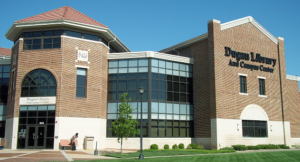

During the Fall of 2015, Newman University’s Dugan Library introduced LibGuides to their community and since then, they’ve seen some amazing jumps in library usage.
Springshare sat down, virtually speaking, with Steve Hamersky (Director) and Jeanette Parker (Assistant Librarian) to get the full details.
When you say you saw a “jump in library usage” – what does that entail?
- Door count is up from previous years by 10%
- Individual consults/long reference exchanges are up by 100% from just one year ago
- Number of students reached in programs, classes, workshops is up 48% from one year ago
- Number of instruction sessions/classes/programs is up 50%
- ILL requests are up 41% – “we feel this is due to them looking closer and searching better, not settling for just full text.”
-

Dugan Library Database Usage:
- Sessions increased by 44%
- Searches are up 40%
- Full text downloads increased by 18%
- Abstract views are up 25%
- LibGuides Statistics since July 1, 2016:
- Course Guides: 4,226 Views
- Subject Guides: 5,283 Views
- Other/Misc Guide: 299 Views
These results are great! Can you tell us, why did you come on board with LibGuides and what kind of guides are you building?
In 2014, the library was issued a mandate to get more involved on campus. Jeanette and Steve worked together and discovered that there wasn’t a program to equip students in research. Furthermore, the library website wasn’t structured to aid students in finding resources for assignments and the Database A-Z list was overwhelming.
Hence LibGuides!
Jeanette began by creating subject guides.
We really wanted something that would focus on a particular discipline and guide students to successfully locate good quality resources and not be using Google to search, which seems their default. We also noticed that many students were overwhelmed with the database options available, so this created a kind of barrier for their searching, they weren’t sure where to start, couldn’t remember what we’d told them, etc. So we wanted to create something that would eliminate the guesswork enabling them to focus on searching and evaluating sources.
Once the Subject Guides were complete, it was time for Steve and Jeanette to look for a professor willing to collaborate on a course-specific LibGuide. To visually differentiate course guides from subject guides, Jeanette uses tabbed navigation for subject LibGuides and side navigation for course LibGuides.
“The first course guide was definitely an experiment, trying to get the right balance of what we felt was important for students and including the elements that instructors needed. During the spring semester (2016) we created 5 different course guides and introduced them in classes. We strongly encourage a library visit to introduce the students to the guide and the majority of faculty are on board with this.
How did you get faculty on board with building course-specific LibGuides?
Steve and Jeanette have created a pattern of visiting with faculty and presenting on the library’s “new” tools and information.
We spend about 15 minutes talking about what new library services or resources we have. This fall we talked to them about our LibGuide stats and with samples of course guides to show them, most responded very favorably to the concept. We discovered that when we described, their initial response was that they feared we were helping students cheat on assignments. With samples to show and say Professor so and so had us show their students this, that response changed. We were able to add 12 course specific guides this fall 2016 semester. Each of these were paired with a visit to the class or library for an introduction.
So not only are Steve and Jeanette promoting course-specific resources to reduce library anxiety, but they’re increasing usage of library resources and their instruction sessions output to boot!
What is the biggest hurdle you face and how is LibGuides helping?
Newman University is located in Wichita, Kansas and most students come from the local area high schools, which do not have librarians.
Students have not met or seen a library since middle school or even elementary school in some cases. They have no idea what we do, what we have to offer them, and how to even make use of the library resources. We have found the LibGuides have helped bridge that gap to certain extent.
Any interesting comments or responses from your users to share?
Faculty Comments:
- “This is amazing! Thank you, thank you, thank you. I am genuinely excited!” –Paralegal Studies professor regarding course LibGuide.
- “This looks FANTASTIC Jeanette! Thank you so much for putting this together. I look forward to your class visit on Thursday!”—Criminal Justice professor regarding course LibGuide
- “This is awesome! I really like the characteristics of an academic, peer-reviewed article, and the list of things needed in their citations is perfect. Thanks again for all of your work on this.” –Biology professor regarding course LibGuide
- “Thank you for doing this! It looks good to me and I think it will help students… I don’t know if it’s possible to overemphasize learning and finding “controlled language” in searches.” –English professor regarding course LibGuide
Student Feedback:
- “I’m finding the resources you have made available in LibGuides and databases much more comprehensive and user friendly than my graduate school. You should be so proud of your work. You have truly made a difference for us, and I appreciate everything you continue to do for me.” –Nursing student (alum)
What’s next for the Dugan Library?
Even though they’ve just started, Jeanette and Steve have some great advice for new users.
I would highly encourage librarians who are just getting started to create templates for different guide types, makes building new guides so much easier and consistent with your overall plan.
Overall, Jeanette and Steve are really pleased with their LibGuides and the results they’ve seen thus far.



Jeanette and Steve:
Our Social Work students love the Social Work LibGuide page!
Thank you very, very much for developing this for our students.